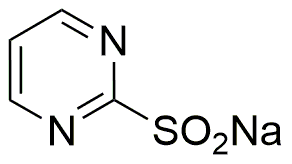Sodium pyrimidine-2-sulfinate is widely utilized in research focused on:
- Pharmaceutical Development: This compound serves as a building block in the synthesis of various pharmaceuticals, particularly in creating drugs that target specific biological pathways.
- Agricultural Chemistry: It is used in the formulation of agrochemicals, enhancing the efficacy of pesticides and herbicides by improving their stability and solubility.
- Analytical Chemistry: Sodium pyrimidine-2-sulfinate acts as a reagent in analytical methods, aiding in the detection and quantification of other chemical substances in complex mixtures.
- Biochemistry Research: Researchers utilize this compound in biochemical assays to study enzyme activities and metabolic pathways, providing insights into cellular functions.
- Material Science: It is employed in the development of novel materials, particularly in creating polymers with enhanced properties for various industrial applications.
General Information
Properties
Safety and Regulations
Applications
Sodium pyrimidine-2-sulfinate is widely utilized in research focused on:
- Pharmaceutical Development: This compound serves as a building block in the synthesis of various pharmaceuticals, particularly in creating drugs that target specific biological pathways.
- Agricultural Chemistry: It is used in the formulation of agrochemicals, enhancing the efficacy of pesticides and herbicides by improving their stability and solubility.
- Analytical Chemistry: Sodium pyrimidine-2-sulfinate acts as a reagent in analytical methods, aiding in the detection and quantification of other chemical substances in complex mixtures.
- Biochemistry Research: Researchers utilize this compound in biochemical assays to study enzyme activities and metabolic pathways, providing insights into cellular functions.
- Material Science: It is employed in the development of novel materials, particularly in creating polymers with enhanced properties for various industrial applications.
Documents
Safety Data Sheets (SDS)
The SDS provides comprehensive safety information on handling, storage, and disposal of the product.
Product Specification (PS)
The PS provides a comprehensive breakdown of the product’s properties, including chemical composition, physical state, purity, and storage requirements. It also details acceptable quality ranges and the product's intended applications.
Certificates of Analysis (COA)
Search for Certificates of Analysis (COA) by entering the products Lot Number. Lot and Batch Numbers can be found on a product’s label following the words ‘Lot’ or ‘Batch’.
*Catalog Number
*Lot Number
Certificates Of Origin (COO)
This COO confirms the country where the product was manufactured, and also details the materials and components used in it and whether it is derived from natural, synthetic, or other specific sources. This certificate may be required for customs, trade, and regulatory compliance.
*Catalog Number
*Lot Number
Safety Data Sheets (SDS)
The SDS provides comprehensive safety information on handling, storage, and disposal of the product.
DownloadProduct Specification (PS)
The PS provides a comprehensive breakdown of the product’s properties, including chemical composition, physical state, purity, and storage requirements. It also details acceptable quality ranges and the product's intended applications.
DownloadCertificates of Analysis (COA)
Search for Certificates of Analysis (COA) by entering the products Lot Number. Lot and Batch Numbers can be found on a product’s label following the words ‘Lot’ or ‘Batch’.
*Catalog Number
*Lot Number
Certificates Of Origin (COO)
This COO confirms the country where the product was manufactured, and also details the materials and components used in it and whether it is derived from natural, synthetic, or other specific sources. This certificate may be required for customs, trade, and regulatory compliance.


